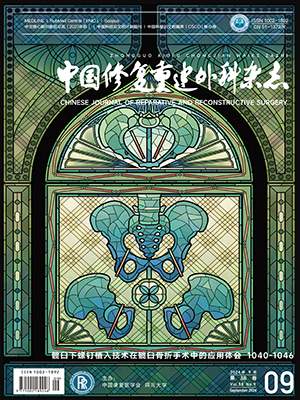Objective To investigate the effect of tissue engineered bone with cryopreservation on healing of bone defects and to explore feasibility of cryopreservation for tissue engineered bone. Methods Tissue engineeredbones were constructed with osteoblasts being seeded onto bio-derived materials made from freshhuman bones,and they were preserved at 4℃ and -196℃ for 3 months and 6 monthsrespectively.They were applied to repair segmental bone defects of rabbit’s radius while the tissue engineered bone without cryopreservation and bio-derived materials were brought into control groups.The experiment was divided into groups A3,A6,B3,B6,C and D(group A3:tissue engineered bones were preserved at 4℃ for 3 months; group A6:tissue engineered bones were preserved at 4℃ for 6 months;group B3:tissue engineered bones were preserved at -196℃ for 3 months; group B6:tissue engineered bones were preserved at -196℃ for 6 months; group C: tissueengineered bones without cryopreservation; group D: bio-derived materials). Macroscopical and histologial examination were done at the 2nd,4th,6th,12th weeks, X-ray examination was done at the 6th,12th weeks and biomechanics were determined at 12th weeks after operation respectively. Results Macroscopical observation showed no significant differences among group A3, A6, B3, B6 and C, but less new bone formation and more obvious boundary in group D were observed. Histological observation showed more collagen and new bone around the edge of implant of group A3, A6, B3, B6 and C than group D, and histological evaluation showed significant differences between group D and other groups(P<0.05). Radiographic observation showed no absorbability of the implant cortex and less new bone formation in group D, but the unity between implant and host bone, medullary cavity reopened, disappearance of fracture line and fine bone modelling were observed in other groups at 12 weeks after operation. Biomechanics between group D and other groups showed significant differences(P<0.05). Conclusion Cryopreservation (4℃ and -196℃) were capable of preserving tissue engineered bone for long time, and tissue engineered bone withcryopreservation has significant effect on healing of bone defects. The methods f it clinical application.
Citation: LUO Xiaozhong,YANG Zhiming,DENG li,et al.. EXPERIMENTAL STUDY OF TISSUE ENGINEERED BONE WITH CRYOPRESERVATON ON HEALING OF BONE DEFECTS. Chinese Journal of Reparative and Reconstructive Surgery, 2005, 19(7): 569-573. doi: Copy




